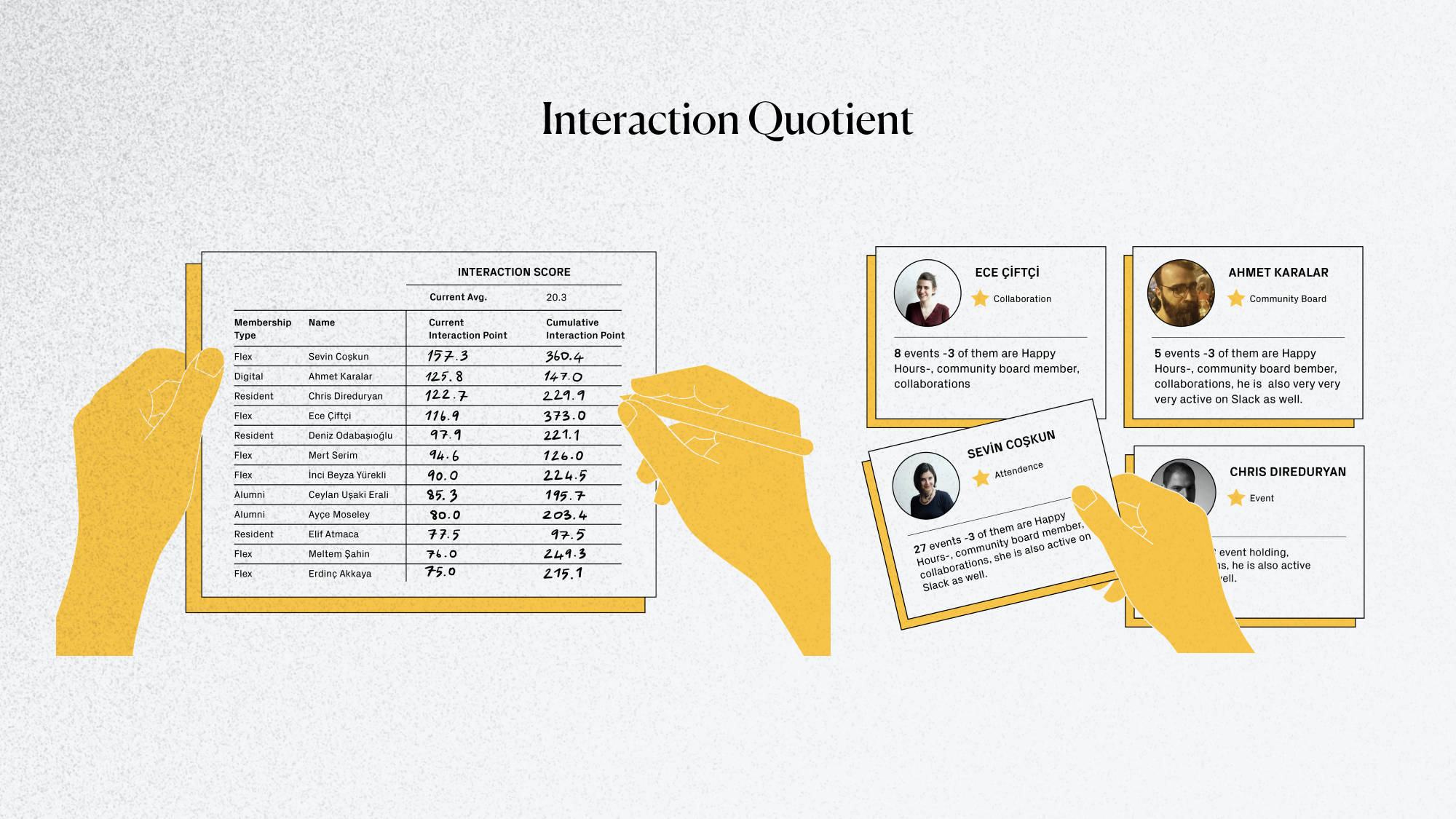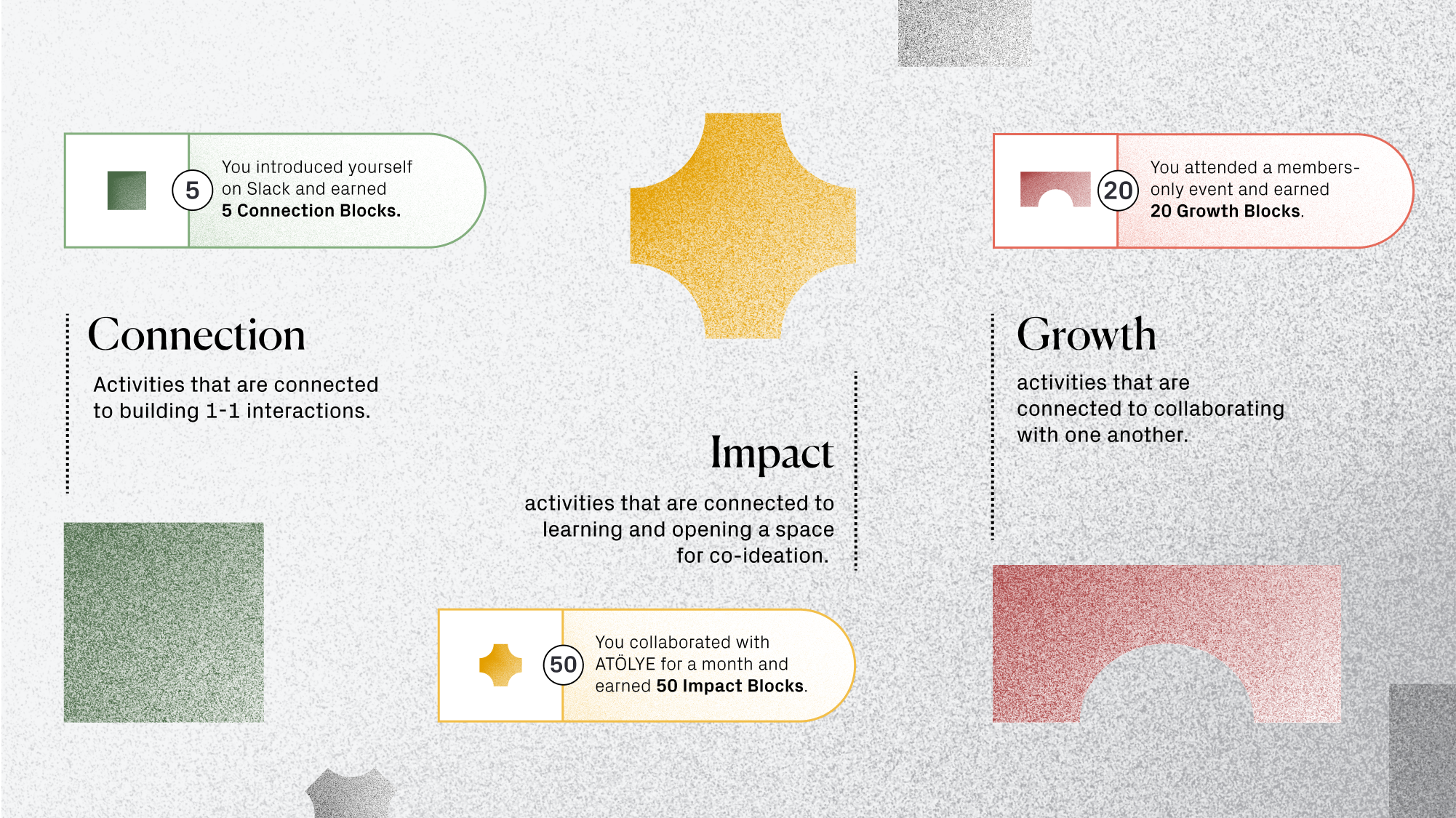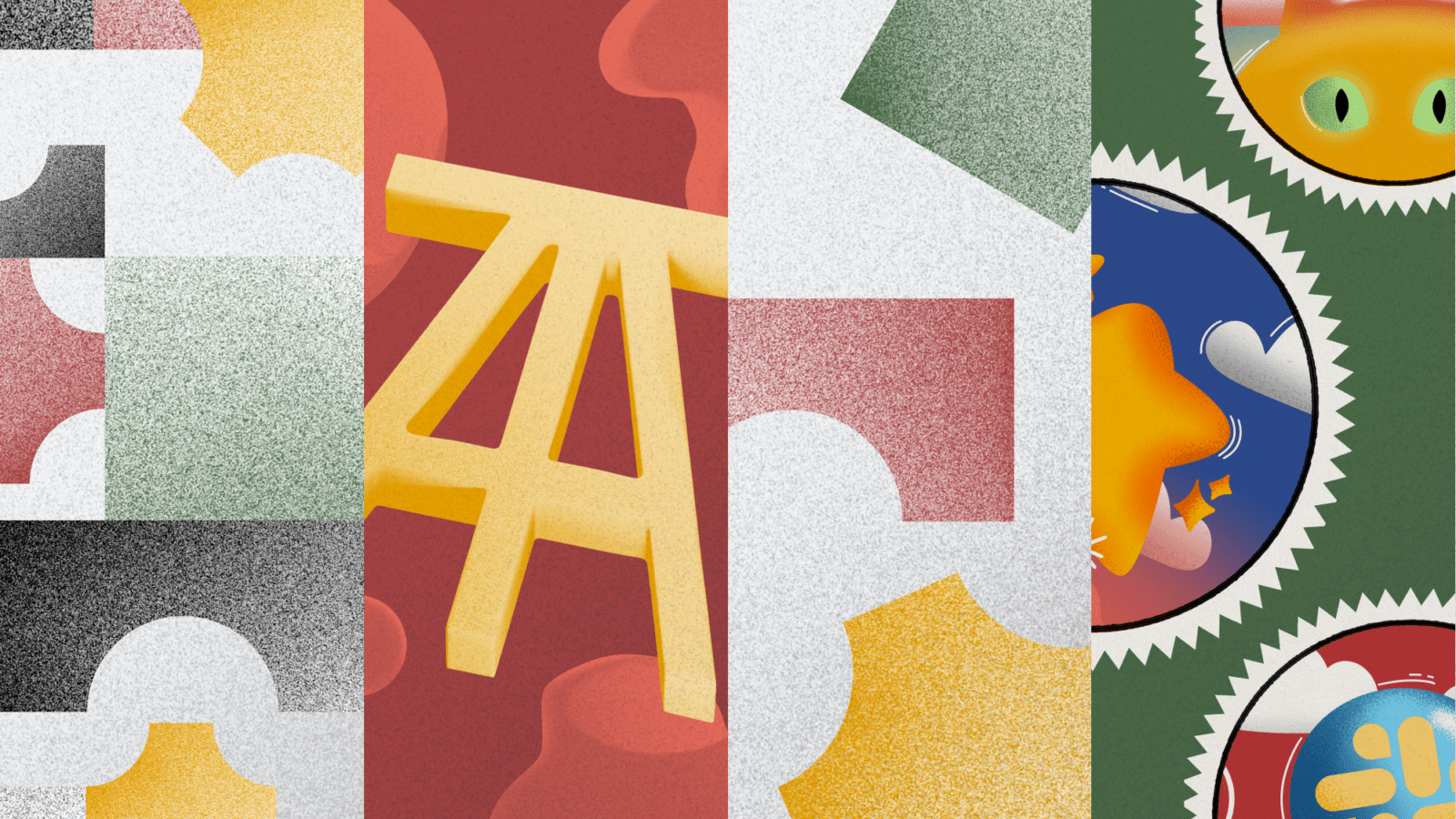Gamifying Community
Published in ATÖLYE Insights · 8 min read · June 1, 2023
How we unlocked member engagement through incentives & rewards
Authors: Atalay Akpınar, Busra Serdar, dana shashaa Editors: Leen Sadder, Melissa Clissold, Nikkole Mojica Visuals: Tikuna Adeishvilli
Summary (TL;DR)
In this article, we share the behind-the-scenes of how we gamified our community model to boost member engagement in the ATOLYE Community. Through a proprietary incentive system called Blocks, we replaced traditional membership fees with meaningful contributions, encouraging reciprocity & collaboration. Read on to learn how members collect Blocks, unlock membership levels, earn badges, and receive rewards aligned with our core values of connection, growth, and impact.
Introduction
If you ask any community builder or practitioner what keeps them up at night, they will likely respond with something along the lines of:
How do I keep members of my community active and engaged? How do I get members to contribute their time and energy meaningfully?
Over the past decade, we at ATÖLYE have been building and nurturing a creative community of individuals who are motivated by impact-driven work. Our 250+ members consist of designers, thought leaders, change makers and social innovators who are the basis of our community-powered model, which places relationships and collaboration at the core of our design and innovation consultancy.
A legacy system, revisited.
Long before community engagement emerged as a hot topic, a unique feature of the ATÖLYE community was a proprietary system we developed known as The Interaction Quotient. The system was designed to quantify the contributions of our members using a variety of coefficients, which we then used to incentivize the most active members, rewarding them with a month of free membership. This early experiment in incentivization helped underscore what we believe are the building blocks of the ATÖLYE community: connection, growth, and impact.

Like many communities, the 2020 pandemic significantly reshaped the way our members interacted with one another and with ATÖLYE. With our physical hubs no longer serving as the primary attraction, we found ourselves re-evaluating almost every aspect of our community building approach, including how we curate and incentivize our members.
Going back to the drawing board, we looked at what was successful and what required change, and re-designed our entire community model to better suit the evolving needs of our members post-pandemic.
We transitioned from a paid creative community with a membership model that relied heavily on physical space and membership fees, to a free community of practice, where our membership model is enhanced by physical space but primarily driven by engagement levels.

To do this successfully, we had to find new ways to incentivize members - and that's where gamification comes in.
Introducing: Blocks.
As creatures who thrive on competition, it's no surprise that many of our daily habits and activities have become gamified - from the way we exercise or meditate to the way we travel or learn a new language, and even how we find love.
Inspired by the rise of gamification, especially in decentralized networks and Web3, we set out to design a new version of the Interaction Quotient that replaces traditional membership fees with meaningful contribution and reciprocity.
Enter: Blocks.
Modeled after the concept of building blocks, we launched Blocks as a way to ensure that our members stay engaged and active, using a play-to-win approach inspired by loyalty point systems.
In short: Blocks are points that members collect whenever they engage in activities that add value to the community & organization as a whole. Blocks accrue over time to unlock membership levels & perks, and certain repeat behaviors unlock honorary badges that can be exchanged for monetary one-off rewards.
Four Principles for Community Gamification
Here's a behind-the-scenes look at how Blocks was built.
1. Align your incentive structure with your core values.
As a community of practice, we are anchored by our core values of Connection, Growth, and Impact. These became the perfect starting point to anchor the Blocks system in, and we turned them into 3 Block types members can collect.
Connection Blocks are collected through activities that foster relationships - such as introducing yourself on our community Slack, or referring a new member to the community.
Growth Blocks encourage activities connected to learning and knowledge-sharing - such as hosting a member spotlight or joining our mentorship program.
Impact Blocks encourage activities related to collaboration and co-creation - such as freelancing on an ATÖLYE project, or starting a new initiative with a fellow member.

2. Embrace complexity, but design for simplicity.
While designing Blocks, we wanted to incorporate game-like elements that would generate excitement and interactivity. To do this, we introduced Levels, as well as Badges and Rewards.

Block WeightsAs members take certain actions in our community, they collect Blocks. Blocks are assigned a weight based on the effort required for each activity, as well as how important they are to the ATÖLYE ecosystem. For example, co-hosting an event at one of our hubs is equivalent to 30 Impact Blocks, while adding a resource to our collective Learning Library is equivalent to 2 Growth Blocks.
Membership Levels

Studies* show that people are more likely to stay engaged and involved when they feel intrinsically and extrinsically motivated—and we all enjoy that sense of accomplishment when we level up!
Blocks that you collect over time let you unlock four different membership levels: Base, Pillar, Arch, and Bridge. These levels then give access to a variety of perks such as mentorship opportunities, our learning library, and more. The more levels you unlock, the more value you inherit.
- Base is automatically activated after onboarding. [5 Blocks]
- Pillar lets you unlock features that are related to growth. [50 Blocks]
- Arch gives access to the wider organizational ecosystem with opportunities to create impact. [200 Blocks]
- Bridge welcomes connection through strong bonds and support mechanisms within the member journey. [600 Blocks]
Badges & Rewards

Inspired by the notion of streaks in gaming, we designed activity-based challenges that reward members for consistency & proactivity. In parallel to collecting Blocks, members can also earn honorary badges that can be exchanged for one-off rewards.
For example, if a member attends 20 events, they earn the Curious Cat badge. If they engage in 500 slack interactions, they get the Slack Master badge. We also introduced the Hub Magnet and Star Collaborator badges to encourage in-person attendance at our hubs, and project collaborations, respectively.
3. Create a sticky story.
Unlike our first engagement system, we felt like creating a user-facing brand and narrative was just as important as the design of the model itself.
We conducted several design sprints to brainstorm and develop a story that would represent our community's culture and philosophy, and landed on a formula that reflects our community ethos:
Connection + Growth + Impact = Belonging
After prototyping several options, we felt that the concept of "belonging blocks" resonated, which eventually was shortened to "Blocks".
We also crafted names for each element (levels, badges, Block types) in a way that would make them memorable and approachable - and shared the story on our community notion page. We were careful to define critical verbs that represented milestones or encouraged activities in the model, such as "collecting" Blocks, "unlocking" new levels, and "earning" badges.

4. Be scrappy, but smart.
As community practitioners, we were adamant about implementing a solution that would keep operational processes to a minimum - so automation was key.
With the help of a few community members and our tech team, we built our first Minimum Viable Product using our favorite no-code tool, the one and only Airtable. All member activities are logged, tracked, and updated through a centralized, automated dashboard using the interfaces feature. We also integrated a few of our frequently used work management tools, such as Slack, Asana, Notion, and Typeform, and used CommonRoom and Orbit to monitor and pull data related to our slack channels.

The next step was designing the operational flow for the new model, including refining workflows between community and team members, updating tracking systems monthly, and creating internal guides.
Since the system has been in effect, we've had over 14 community members unlock new levels, increased engagement by 4.5% percent on Slack (over 2 months) and hosted over 14 member-only events where members have collected 3,300 Blocks collectively.
Game on.
In our quest to boost community engagement (a tough nut to crack!), we used gamification & a no-code solution to measure and reward member interactions. By aligning activities with our core values, we fostered connection, growth, and impact within our community - but we're only just getting started.
The Blocks project is one of many experiments we've run as part of our newly launched ATÖLYE Community Lab, a space to explore the art and science behind fostering truly engaged communities.
If you are a community practitioner or an organization interested in becoming community-powered, reach out to us to schedule a chat by emailing community@atolye.io.
***
Resources:
Understanding Communities of Practice by Commsor
What do we mean by engagement?
Interaction Quotient <https://medium.com/atolye/interaction-quotient-2420a305d130>
Engagement tips and tools by David Spinks <https://support.mobilize.io/hc/en-us/articles/360037598432-Engagement-tips-and-tools>
Do Immediate External Rewards Really Enhance Intrinsic Motivation? Frontiers in Psychology; Liu, Y., Yang, Y., Bai, X., Chen, Y., & Mo, L. (2020).
Immediate rewards predict adherence to long-term goals. Personality and Social Psychology Bulletin, 44(2), 192–208; Woolley, K., & Fishbach, A. (2018).
